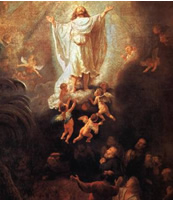 |
The
Ascension of Jesus Christ Rembrandt van Rijn, 1639 |
He presented himself alive [to the apostles] after his suffering by many proofs, appearing to them during forty days and speaking about the kingdom of God...And when he had said these things, as they were looking on, he was lifted up, and a cloud took him out of their sight. And while they were gazing into heaven as he went, behold, two men stood by them in white robes, and said, “Men of Galilee, why do you stand looking into heaven? This Jesus, who was taken up from you into heaven, will come in the same way as you saw him go into heaven.” (Acts 1: 1-11)
The passage above, taken from the first chapter of the book of Acts in the Christian New Testatment, tells of how, for forty days following Jesus’ crucifixion and death, his disciples were made aware of his continuing presence. These mysterious encounters—culminating in the experience described above, when disciples perceived him ascending into heaven—were the foundation for the belief in resurrection.
It is this final encounter which is remembered on Ascension Day, which occurs forty days after Easter. According to tradition, it was first celebrated in 68 CE, although there is no written evidence of the feast until about 385 CE. One of the six holy days of obligation when mass must be attended, it is celebrated predominantly by Catholics and Anglicans.